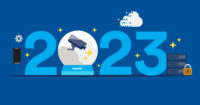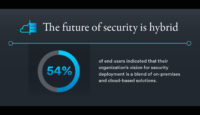The adoption of cloud-based solutions for physical security has been gradually increasing over the past decade, but it is now picking up speed, according to Genetec’s newly released 2024 State of Physical Security report.
According to the survey, 44 percent of end users reported that more than one-quarter of their physical security setups are now either in the cloud or use a combination of cloud and on-premises solutions. This is a significant jump from the 24 percent reported in last year’s survey.
Based on insights from over 5,500 physical security leaders worldwide (including end users and channel partners), the report looks at the security strategies organizations are putting in place to effectively navigate the realities of a changing industry. Following are other key insights from the report.
Cyber concerns about the cloud are diminishing
Cyber concerns about cloud-based solutions are lessening significantly. In last year's survey, end-users considered perceived cybersecurity risks to be the primary factor discouraging their organizations from adopting cloud-based security systems. However, there seems to be a shift in attitudes. This shift underscores growing confidence in the capabilities of cloud solution providers to establish robust cybersecurity measures. As a result, in the 2024 survey, respondents have relegated perceived cybersecurity risks to the sixth position among the factors deterring their organizations from adopting security systems in the cloud.
Channel expects increased demand for cloud and hybrid solutions
Feedback from channel partners also supports the idea that end users are eagerly shifting toward cloud solutions. A substantial 74 percent of channel partner respondents anticipate that more of their current customers will embrace cloud connectivity for security in the coming year. Furthermore, 39 percent of channel partners stated that they prioritize cloud-based solutions whenever possible, and an additional 52 percent offer cloud-based solutions upon customer request.
IT and physical security departments are increasingly interconnected
The increasing adoption of cloud-based physical security systems has led to a rise in cybersecurity threats, data handling and compliance requirements. As a result, IT and physical security teams are becoming increasingly interconnected as evidenced by 55 percent of end users indicating that the IT department has access to physical security data. As technology adoption grows and remote access from external networks becomes more common, the partnership between IT and physical security will continue to develop.
The future looks hybrid
It appears that most organizations will prefer a hybrid approach, combining both on-premises and cloud-based solutions. Sixty percent of end-user respondents revealed that their organizations aim for a security deployment strategy that combines both. The transition to hybrid systems is already in progress, with 15 percent of end users stating that their organizations are currently storing video surveillance data both locally and in the cloud, marking a notable increase from the 4 percent reported in last year’s survey.
“A hybrid cloud deployment clearly emerges as the ideal path forward for many organizations, seamlessly blending local infrastructure with the power of the cloud," said Christian Morin, vice president product engineering / chief security officer, Genetec. “With a hybrid-cloud solution, organizations can optimize their physical security installation to best fit their business. And no matter how their security needs evolve, their systems will remain agile and adaptable to continue providing them with the capabilities they require.”
Genetec surveyed 5,554 physical security professionals, including end users and systems integrators, from Aug. 21-Sept. 15. Survey samples were run across all regions including North America, Central America, Caribbean, South America, Europe, Middle East, Africa, East Asia, Southern Asia, South-Eastern Asia, Central Asia, Western Asia, and Australia-New Zealand.
To download a full copy of the report, go here.



